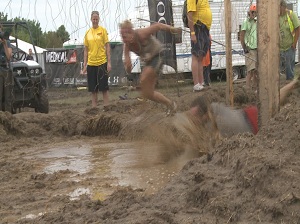A couple of weeks ago I agreed to run a Tough Mudder with a couple of hockey buddies. The one I said I’d do is in Charlotte this fall, and I’m reconsidering. CDC’s MMWR (my favorite Thursday read) has details of an outbreak of Campylobacter associated with a 2012 Nevada mud run. According to Zeigler and colleagues, the epidemiological data suggested that the inadvertent swallowing of surface water in one of the obstacles was a risk factor.
A case-control study using data provided by patients and healthy persons who also had participated in the race showed a statistically significant association between inadvertent swallowing of muddy surface water during the race and Campylobacter infection (odds ratio = 19.4; p<0.001). Public health agencies and adventure race organizers should consider informing race attendees of the hazards of inadvertent ingestion of surface water.
High-intensity and competitive muddy obstacle adventure course races have surged in popularity across the United States, drawing an estimated 1.5 million participants in 2012 (2). These military-style adventure races attract high numbers of active-duty military personnel, along with young, active, extremely fit civilians. Persons typically are advised of the risks of participating and required to sign a liability waiver. Races are commonly held on farmlands where animal feces increase the risk for zoonotic disease transmission. Primary and emergency care providers, as well as public health professionals, should be aware that obstacle adventure race events could pose a heightened risk for outbreaks from inadvertent ingestion of contaminated water or mud and might consider outreach to educate participants on the health risks from oral contact with contaminated surface water or mud.
Participation in obstacle adventure races is relatively common among men and women of the U.S. military. These events typically are held in rural areas and often include man-made slurry fields (a mixture of soil or clay and water) as race “challenges.” In areas commonly frequented by animals (5), topsoil used in the creation of slurry fields can be contaminated with feces from domestic fowl (6) or ruminants (7) or wild animals. Competitors who run or ride through such areas might unintentionally swallow sufficient numbers of organisms to cause clinical disease. Fewer than 500 Campylobacter organisms are needed to cause illness (1). The race described in this report was held on a cattle ranch, and participants reported seeing cattle and swine on or near the course on race day. Obstacle adventure race planners should consider building slurry field challenges where animal fecal contamination is not likely.
Public health agencies and adventure race organizers should consider informing race attendees of the hazards of inadvertent ingestion of surface water.
Yep.
